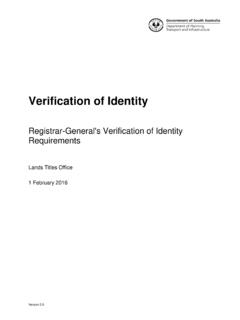Transcription of DC to DC Dual Battery Charger Manual - AUTOELEC.COM.AU
1 Part Number: DBDC10 / DBDC20DC to DC Dual Battery Charger Manual For your personal safety read, understand and follow the information provided in this instruction Safety Instructions WARNING! To avoid any personal injury, please read the safety instructions Battery Charger is not intended for use by children or infirm persons without AUTOMOTIVE AND RECREATIONAL VEHICLE 12V DEEP CYCLE Battery USE TO BE USED WITH DRY CELL BATTERIES. During the charging process, do not use a naked flame near a Battery . Batteries generate explosive gasses during the charging process that may explode. Never smoke or light cigarettes near a Battery . Do not place tools on top of a Battery or allow tools to fall on the Battery to prevent the chance of a short circuit and sparks.
2 Always wear eye protection when charging a Battery . Ensure charging and testing is conducted in a well-ventilated area. Inadequate ventilation may over-heat the Charger and cause in-efficient operation. This Battery Charger is not intended for outdoor operation. Do not expose it to moisture or extreme weather conditions. The ACID/FLUID within a Battery is highly corrosive and poisonous. It can produce flammable and toxic gases when recharged and will explode if ignited, When working with batteries, always wear eye protection , remove jewellery and ensure the area is well ventilated. If spilt - it will cause severe burning to eyes, skin, clothing, damage paintwork and corrode many metals. Ensure that power is disconnected from any appliance in the vicinity of the spill and immediately wash any area that has been affected with water.
3 The warnings, cautions and instructions detailed in this instruction Manual cannot cover all possible conditions and situations that may occur. Common sense and caution are factors, which cannot be built into this product and must be supplied by the Charger FeaturesThis DBDC10/ DBDC20 Charger is a sophisticated multi stage Charger , utilizing switch mode and fully automatic computerised control, designed to charge most 12 Volt Gel, Lead Acid and Calcium batteries. Heavy duty aluminum case and mounting brackets Microchip monitoring and control Fully automatic hi frequency multi stage charging Pulse mode technology that reduces oxidation, evens electrolyte consistency and minimizes temperature equating to longer Battery life Easy push button chemistry select; GEL, Calcium, Deep Cycle, VRLA and conventional flooded lead-acid batteries.
4 Internal Charger temperature monitoring and power output control. LED indicators showing state of charge Over charging, short circuit and over temperature protection . Reverse polarity protection Installing the Charger Installation of this unit will require twin core wiring - and suitable cable connectors (not included). See specifications page for existing cables used in conjunction with this Charger will require checking to ensure size is suitable gauge. Where necessary replace with suitable gauge wiring if they do not meet minimum specifications. Locate where you are going to install the DC-DC Charger . Ensure the Charger is located in a suitable non-wet area in the vehicle or caravan. Ensure the Charger is securely mounted using the brackets and screws provided. Charger can be mounted overhead, vertically or horizontally.
5 Next, measure required cable length from the main vehicle Battery through to the location of the DC-DC Charger . Ensure ALL cabling meets specification and will not be exposed to excessive heat/moving parts or abrasion. Installation Options/ InstructionslREAR(+) DC INPUT(+) Charger OUTPUT(-) SHARED NEGATIVE ChargerChargerAuxiliary BatteryAuxiliary BatteryAnderson Style PlugMain Vehicle BatteryMain Vehicle BatterySuggested fitment to vehicle only Suggested fitment to vehicle with caravan If the Charger is located in a camper/caravan we recommend the use of an Anderson style plug between the tow vehicle and the camper/caravan as shown below. Fit suitable connectors on either end of the twin core cables. Connect the auxiliary Battery to (-) shared negative and (+) Charger output using twin core wiring as per recommended cable size.
6 Using the twin core wiring laid between the main starting Battery and the DC-DC Charger , connect the red (+) to the (+) DC input terminal and the black (-) to the (-) shared negative on the rear of the Charger . Finally, make the power connections to the main starting Battery of the vehicle. It is recommended to install a 25amp circuit breaker (not included) as shown on main diagram. The circuit breaker should be located close to the starting Battery . Check all connections are the ChargerOnce correctly installed the Battery Link DC-DC Charger is a simple set and forget dual Battery switch. Start the vehicle and let it idle. The Charger will now recognize that there is charge being applied to the main starting Battery . Once the main starting Battery has reached volts the Charger will automatically turn on.
7 Once the voltage reaches volts the Charger will begin to charge the auxiliary Battery . The initial default setting is for lead acid batteries. If you are charging a Battery with a different chemistry simply change the Battery type by pressing the Battery type selector button on the front of the Charger . Once selected, the Charger will remain on this Battery type until it is changed. The Charger will continue to operate even after the vehicle has been switched off, however once the main starting Battery falls below volts the Charger will automatically shut off. Failure to use recommended wiring will severely impact on performance of DC to DC :DBDC10 / DBDC20 Type:Multi StageInput to Volts DC Output / Charging (stops charging when alternator output or vehicle Battery below )Output Current: DBDC10 DBDC2010A20 AMinimum Start Volts - for Battery being chargedCharge ControlSoft Start:Ye sBulk (Gel) (SLA) (Cal)AbsorptionConstant voltage with automatic amperage (Gel) (Cal) (SLA) Battery Range: 18 to 250 AhCable Length/ Twin Core0 - 1 Mtr6mm/17 AWG1 -5 Mtr8 B&S/8 AWG5 Mtr +6 B&S/6 AWGWARNING!
8 Charging voltages: GELLEAD ACIDCALCIUM Charging algorithm will change according to Battery informationDeep cycle batteriesIt is expected that this Charger will be used to charge a deep cycle type auxiliary Battery . Deep cycle batteries are designed to provide Battery power to run items like fridges and lighting in caravans and campers. It is generally accepted that the life of a deep cycle Battery can be extended if it is not discharged below 50% of its full capacity. A fully charged 100amp Battery in good condition should offer 50amp hours of power without impacting on its normal life average compressor style fridge uses up to 5 amps. Over a 24 hour period it should use approximately 24 amp hours. Therefore if the 100AH Battery is operating only the fridge (and receives no additional charge) it ideally will require recharging after 48 hours.
9 To replenish these 48 amp hours using a 10 amp DC-DC Charger will require at least 5 hours of driving. A twenty amp unit will require at least hours of driving to fully recharge the Battery . Undercharging a Battery and discharging to below 50% can severely impact on life expectancy of most deep cycle batteries. The readings are taken at room temperature of 26 C (78 F); the Battery had rested for 24 hours after charge or readings & specific gravity of electrolyte (lead acid batteries) can give an indication of your Battery state of state-of-chargeAverage specific gravityOpen circuit voltage 12V100% information TIPS We highly recommend that both the starting Battery and deep cycle auxiliary Battery are checked by a reputable automotive store or Battery reseller to establish the health of your batteries.
10 (Most outlets offer this as a free service using digital equipment). If your Battery is:1. Over 3 years Has been fully discharged at some stage (Example: headlights left on for several hours then vehicle required jump starting).3. Has not been recharged or used in past 3 Has been stored in a discharged Has any evidence of damage or bulging to Battery casing . After returning from trip and parking-up your camper/van it is good practise to remove all electrical connections from Battery . The batteries should then be fully recharged and ideally maintained using a smart Charger (see Battery Link Pro Series Smart chargers). CHARGINGPOWER Part No: MCU08012V 8000mAPart No: MCU01212V 12000mAFault Finding Charger won t indicate charging. Battery won t charge. Battery won t fully charge or hold charge.






